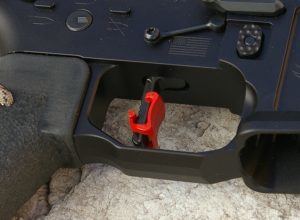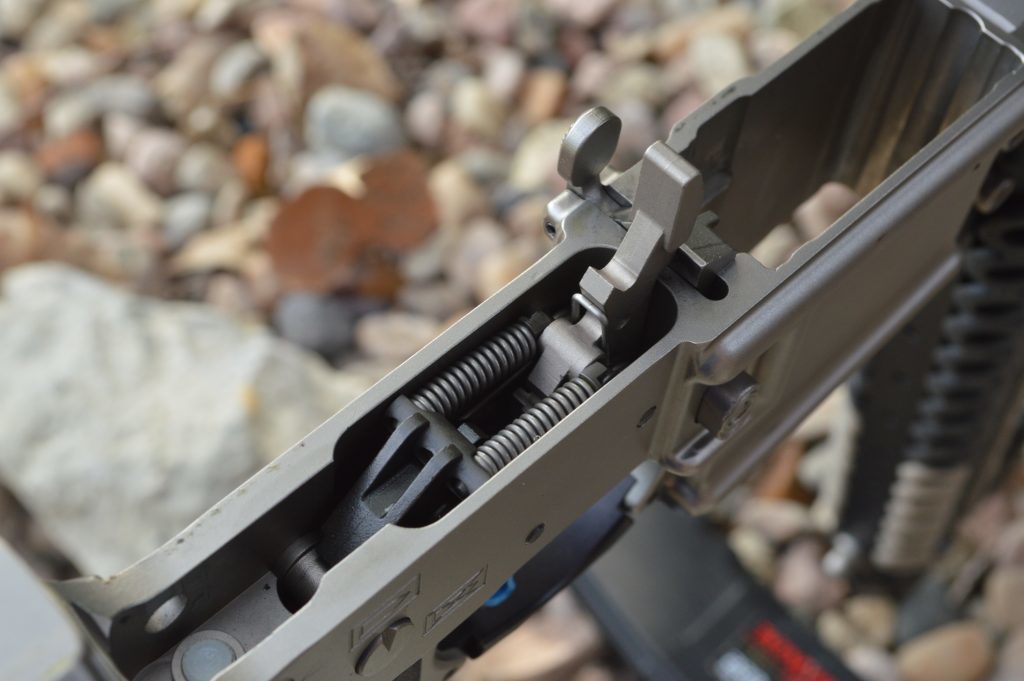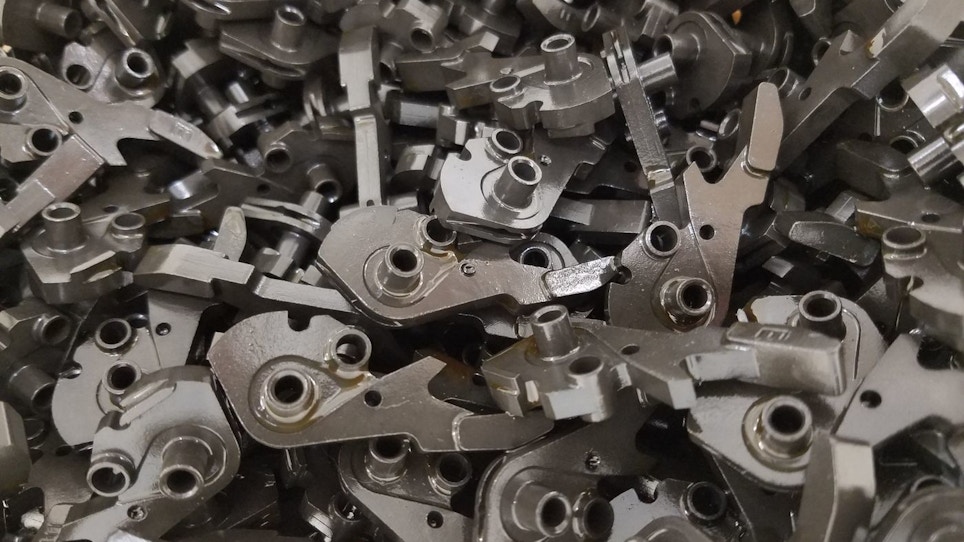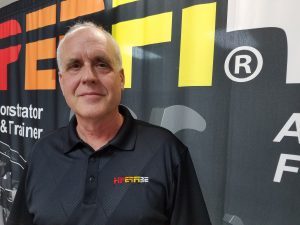When retailers and distributors hear about yet another new AR-15 trigger there is either an emotional excitement about some fast sales or an eyeroll. In the case of HiperFire triggers, customers, retailers, distributors and competitors were all shocked how abruptly HiperFire hit the market in 2014. It seemed that literally months after the first shipment of triggers, 3-gun competitors switched over to HiperTouch triggers and customers sought them out.
Instead of another tuned AR trigger based on traditional Mil-Spec geometry or a remake of an existing cartridge trigger style, HiperFire created its own completely new unique patented single-stage trigger design that solved many of the complex tuning challenges of AR triggers. It seemed HiperTouch 24 series triggers were everywhere in the fast shooting 3-gun market and quickly captured a large customer base in just two years. Tactical Retailer had an opportunity to visit the HiperFire facility and with Terry Bender — founder, CEO and mechanical engineer behind HiperFire.
TR: As I walk through this spotlessly organized and uncrowded facility, I cannot help but notice dozens of boxes filled with raw parts and completed trigger sets ready for shipment.
BENDER: Yes, we try to keep a good inventory of component parts. Throughout the HiperFire line there are many components that are shared amongst the triggers such as springs. It makes a lot of sense to keep enough on hand to accommodate unexpected higher volume orders of one model or another. As a new company, we also want to assure dealers and distributors can get product when they need it. We do have plenty of room to grow in our current facility and a modest staff. We are dedicated to providing a stable work environment, which means we do run pretty lean. So far, customers keep us busy with orders and keep us growing.
TR: How has HiperFire approached the manufacturing process?
BENDER: We decided early on that the smart way to run our business was to establish our own in-house quality control standards and work with manufacturing partners that specialize in the unique manufacturing needs of each part. We use several manufacturing partners that follow HiperFire’s strict quality control and then we quality check each part after delivery. This manufacturing solution has allowed us to be much more nimble throughout our unexpected growth curve.
TR: How did the concept of HiperFire start?
BENDER: As a mechanical engineer by trade, I had been awarded several military firearms related patents starting around 2005, however my investors were encouraging me to develop parts around the common and prolific AR-15 platform. The goal for everyone involved was that any new patents would start creating revenue in the form of some type of business to take advantage of the surging AR-15 market. That gentle nudge pushed me to take a look at the AR platform from a design perspective and an obvious design challenge was creating a better trigger.
TR: What was your inspiration for a new trigger design?
BENDER: As a casual shooter, I was disappointed overall with the triggers that were on the market. There were gunsmiths grinding down and tuning triggers and aftermarket trigger companies that did have better feeling triggers, however no manufacturer was mechanically addressing the primary problems and shortcomings associated with legacy based trigger design itself. Every trigger option on the market relied on the sear to manage the full weight of the hammer spring, which created a multitude of other issues once the trigger pull was lightened. I set out to design a better trigger to overcome issues of the legacy trigger design itself. The result was a series of patents starting with my 2013 patent that was later released as the HiperTouch 24.

Many competitors are using the HiperTouch 24C on their competition builds such as this SanTan Tactical competition lower receiver.
TR: Are there particular challenges all trigger manufacturers face with their designs?
BENDER: Yes. The ultimate challenge for a great tactical/hunting trigger is to deliver a smooth, fast and flat pretravel, very fast trigger reset, minimize lock time, assure a crisp, light break with no noticeable overtravel, all while delivering a high hammer fall impact and maintaining a drop-safe firearm. With match target triggers, the goals are the same but with even more refinement of all the above, with no perceptible pretravel.
The problem is that many of those trigger design goals are all opposing forces. A smooth, fast and flat pretravel and crisp, light final break all require low forces at the sear, which equates to the need for lighter hammer and trigger springs, which can lead to light hammer strikes and less reliable ignition. Conversely, very fast trigger resets, minimized lock times and high hammerfall impact require heavy springs, which creates a poor-feeling, heavy trigger. The final dimension is tuning out pretravel, overtravel and ensuring a crisp trigger break, which are all impacted by the above light or heavy springs. Poor tuning can further impact reliability and safety.
Historically, the compromise has been either a great single-stage trigger that may have a light hammer strike here and there with hard primers, or a two-stage trigger that delivers a first-stage pretravel that some claim slows down followup shots.
TR: What sets the HiperFire triggers apart from other triggers?
BENDER: We have a number of patents covering our triggers, however the basis of the design is a camming effect that is caused by an off-center pivot point on the hammer that moves the spring power bias as the hammer rotates. The design allows for a very strong trigger spring, but due to the camming effect, the hammer force is reduced dramatically a few degrees before the sear engagement point. For all the HiperTouch models, this patented design feature allows the trigger pull to be very light while the hammer delivers higher than normal hammer fall energy. The camming effect is achieved via both a proprietary hammer spring and additional dual hammer spring struts.
TR: What should retailers tell customers about how the HiperFire HiperTouch triggers are different than any other trigger?
BENDER: The easy way for retailers to think about one of our key differentiating features is to talk about the camming pivot point on the hammer. The unique Hiperfire design delivers the perfect situation for a great feeling trigger and break. After the hammer begins to move forward, the cam applies pressure the other way and greatly increases the hammer force. That increases hammer fall force, decreases lock time, etc. It’s a best of both worlds design — it’s a totally new trigger design.
Another feature of our triggers is that the HiperTouch 24 triggers are user adjustable via included springs, but are not dependent on set screws, which have shown to fail.
TR: How would retailers differentiate between all the HiperTouch triggers?
BENDER: Within the HiperTouch line we have the 24, 24-E and 24-3G, which all feature a traditional curved trigger bow. The main difference is trigger creep. The 24 has a similar creep as a combat duty Mil-Spec trigger but offers a crisp two- to four-pound trigger pull. Though the 3G, G and ECL are the superstars of the line, customers really like the base 24 model for defensive rifles. The 24-E reduces the creep and improves the trigger feel further, and the 24-3G reduces the creep to an imperceptible level and delivers the most crisp trigger feel of the curved trigger bow triggers. The 24C and ECL use the same geometry and feel of the 24-3G, but uses a flat tunable trigger bow. The ECL enhances the 24C with the addition of a nickel alloy finish that delivers a smoother trigger feel.

The HiperTouch 24ECL with nickel coating is right at home in this Marine Nickel Boron coated Barnes Precision Machine AR-15.
TR: How does the EDT line differ from the HiperTouch 24 series?
BENDER: The EDT design carries forward the cam action and trigger geometry of the 24 series, but omits the added cam springs. The design was targeted toward shooters using the AR platform for multi-purpose home defense use, law enforcement and NRA Competition, which all specify a trigger pull of greater than 4 1/2 pounds. The highlights for retailers are that the EDT triggers start with a MSRP of only $89, deliver user-selectable 4 1/2- or 5 1/2-pound trigger pull weights and faster lock times, provides reduced creep, improved overall trigger break and reduced overtravel all while maintaining the hammer fall energy of heavy pull Mil-Spec triggers. The EDT line is now available in the EDT, EDT2 with increased hammer fall energy and EDT3, which incorporates the higher hammer fall energy and a hybrid curved and flat trigger. At a MSRP of $89 to $95, we believe it is one of the best Mil-Spec trigger upgrades on the market for customers.
TR: As I look around your facility, I see a number of products that have not been technically released yet.
BENDER: By the time this article publishes, we should be through the SHOT Show 2017 release of the new HiperGrip, charging handle and muzzle brakes. Our customers have been pushing us to offer more and more products, which has led to expansion into mechanically engineered products like muzzle brakes, improved ergonomic grips and charging handles. Currently the HiperGrip is ready for release.
TR: How would you explain the unique HiperGrip’s advantages over other grips?
BENDER: Just as we have done with our new charging handles and muzzle brakes, we started with a clean slate and created engineered designs that solve problems shooters face. Though the HiperGrip is a departure from traditional grip shapes, the HiperGrip offers a substantial advantage to shooters. The primary design goal was to design a more ergonomically correct grip with corrected grip angle and trigger finger placement and to deliver uniform grip pressure throughout to improve weapon and trigger control. The overall grip is larger than others on the market and does feel different, which was the intent of the design. The overall design that allows trigger pull without additional tension in the hand. One of the other unique features is that the HiperGrip has a channel that prevents the selector from being accidentally disengaged. The grip can be modified to remove the channel for easy access to the selector for defense and competition use.
TR: Can you explain a little about your dealer program?
BENDER: Our dealer program is simple with very low minimum order. We want retailers to get the product on the shelves, experience the HiperFire advantage first hand and do not want them to have to invest a lot to do that. Our retailers are telling us that the HiperFire triggers are the best-selling aftermarket AR-15 triggers they stock due to the rave reviews from competitors and editorial reviews. Any new dealers are always welcome to give us a call to talk about our programs. We also have retail trigger displays, trigger test displays and signage available to support dealers. Stocking dealers are also listed on our site. We like to refer customers where possible directly to dealers.
TR: What would you tell retailers about HiperFire and the where the trigger market is headed.
BENDER: We are still a company that is trying hard to assure our dealers and customers are happy with our products. The feedback has been amazing, so we are doing everything we can to keep that momentum going. There are triggers everywhere in the market, however we believe we offer a unique design that performs better than anything else on the market.
Featured image: HiperFire hammers







